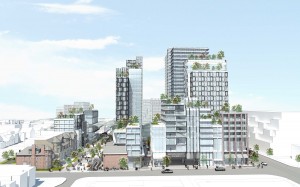Proposal marked by diversity

An artist’s rendering shows the redeveloped Mirvish Village, as envisioned by Westbank in its application to the City of Toronto, from Lennox Street. The proposed development includes purpose-built rental housing, provides accommodations for cycling, and seeks to be as sustainable as possible.
COURTESY HENRIQUEZ Partners architects
By Annemarie Brissenden
The fine-grained retail and eclectic mix of buildings that developed over time along Toronto’s avenues is the inspiration behind Westbank Corp.’s application to redevelop the southwest corner of Bloor and Bathurst streets, which the company submitted to the City of Toronto last month. It’s been two years – two years of public outreach, community consultation, and research – since the company purchased the parcel of land that includes Honest Ed’s and Mirvish Village and is bounded by Bloor, Bathurst, Lennox, and Markham streets.
The application is detailed in a 150-page report that provides the site context, the proposal itself, an urban design analysis, planning policy context, and planning rationale. It is accompanied by draft amendments to the Official Plan and a Zoning By-Law. Both documents detail elements of the future development, named Mirvish Village, and largely cleave to the set of design principles that Westbank previously introduced at its open house in early March.
These 10 principles have been reframed as “benefits to the city” and include arguments for: the creation of a complete community that encompasses “retail, residential, and an array of civic services”; heritage conservation that renews “and extends the site’s history as a vibrant urban space”; an urban market of approximately 30 permanent vendors that recalls “the hustle and bustle of the Honest Ed’s store”; a pedestrian-oriented public realm; and, vibrant local micro and pop-up retail, particularly fine-grained retail along Bloor and Bathurst streets.
The five other principles-cum-benefits are: 1,000 units of purpose-built rental housing, with 50 per cent or more at two bedrooms or more, as well as the introduction of a new daycare; sustainable development that targets LEED Platinum ND certification and Tier 2 of the Toronto Green Standard; development that is transit-oriented and cultivates urban mobility like walking and biking; and, finally, a built form that respects the “site’s unique context, history, [and] surrounding communities” with “slim, vertically oriented building components that together form larger and more dynamic buildings”.
Designed to minimize shadowing and visual impacts on adjacent neighbourhoods, and dubbed micro towers due to their small floor plates that range in size from 500 to 600 metres squared, the application envisages that five of these slim, vertical buildings will range from 15 to 29 storeys.
The application acknowledges that “Bloor Street is predominantly low-rise in this area, [but] it is expected to intensify over time, particularly in the four corners area.” The placement of the towers amongst the lower-rise buildings is meant to mimic the streetwall pattern along Bloor and Bathurst streets, “transitioning down in height as it extends outward from the intersection”. Each tower will have its own style, which is not only a nod to the local built-form, but gives the appearance that the neighbourhood has developed organically and underscores a dedication to diversity.
Although there are common elements that subtly connect the project’s individual components into a cohesive whole, diversity – of building type, residential type, retail type, and even transportation type – is the main driver of this mixed-use development.
It also celebrates eclecticism, honouring the best elements of Mirvish Village and Honest Ed’s, while discounting the worst, such as the way the large format store disrupted “the fine-grained character of retail along Bloor Street”. Westbank proposes to pay homage to Honest Ed’s “iconic, zany signage” by installing “vibrant, eclectic signage” for the retail along Bloor and Bathurst streets, and preserve much of Markham Street’s heritage.
The houses at 588 to 594 Markham St., and 596 to 598, will all be conserved in situ and rehabbed, while 581 to 598, and 593 to 597, will be conserved, rehabbed, and integrated into the new construction. The house at 610 will be relocated to 591 Markham St., and restaurants will be located in conserved historic houses located along the southern portion of the street. A new laneway will provide east/west access for vehicles and pedestrians from Bathurst to Markham streets, while Honest Ed’s lane has been relocated to the west, and designated as an intimate pedestrian space featuring micro retail.
It’s a proposal that values cycling, transit, and pedestrian comfort over cars. It separates vehicles and pedestrians to maximize the public realm, and “all parking and the majority of loading activities have been located below grade”. The application does not specify how many parking spots it will include, but argues that “Mirvish Village strikes a balance between providing adequate parking to address demand and minimize impacts on neighbouring areas while also limiting parking enough to discourage vehicular access as a primary mode of transportation”.
This is part of a series of Gleaner articles on the Westbank development. Upcoming articles will focus on the community’s response to the proposed application, examine specific components of the proposed development, and profile the people involved. For story ideas, or comments, please email gleanereditor@gmail.com.
